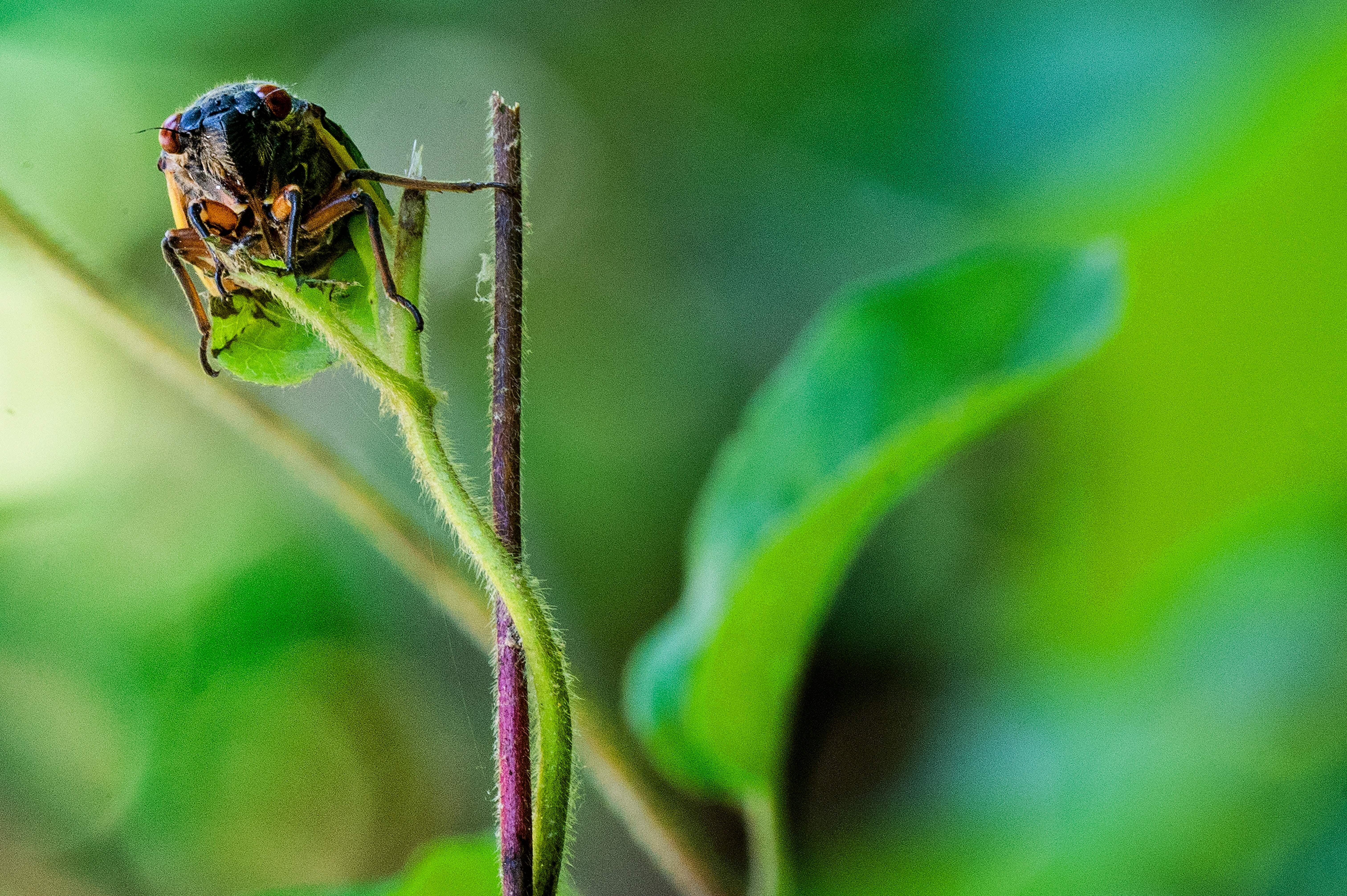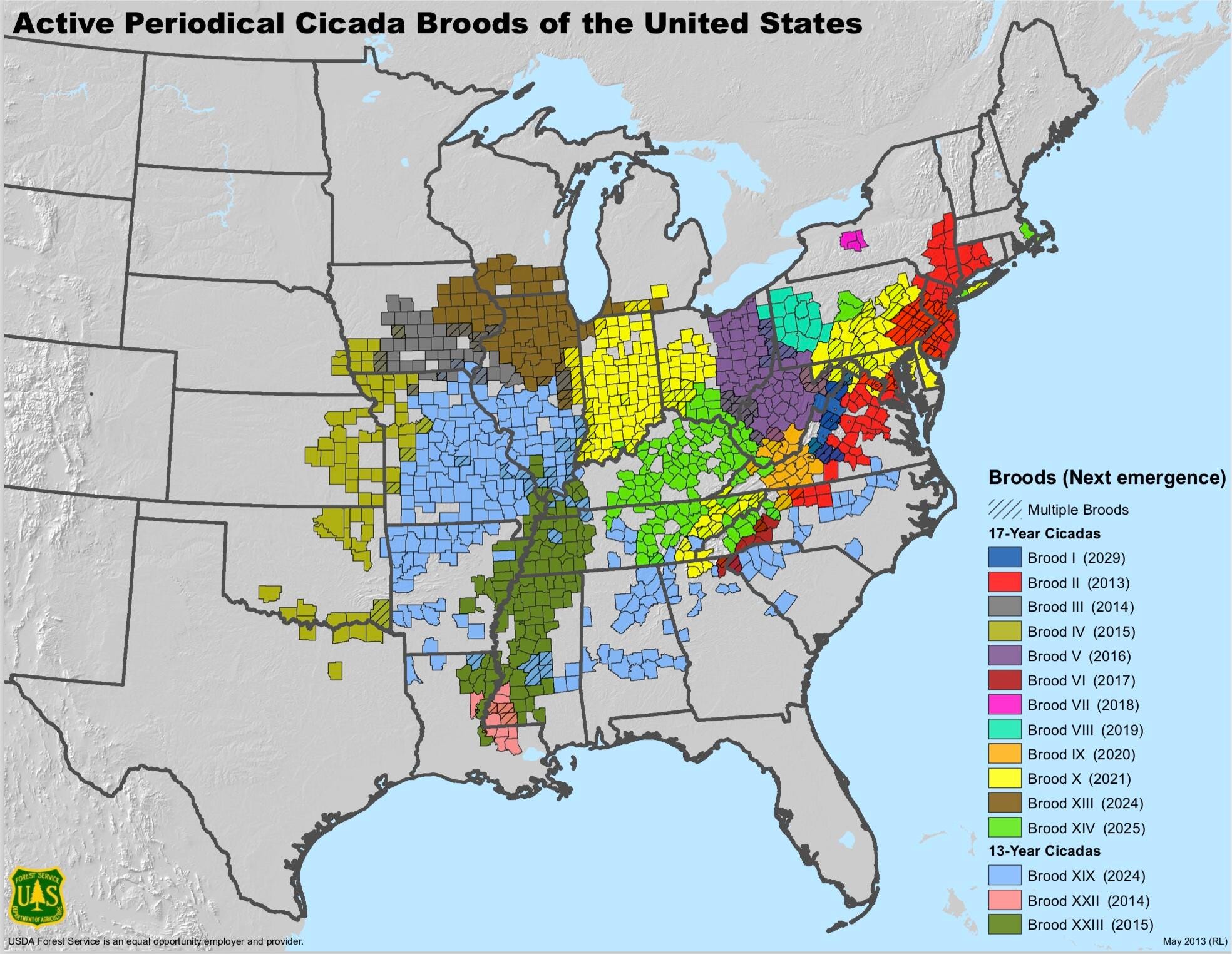
Periodical cicadas emerge from underground in the spring of their 13th or 17th year. Here, a periodical cicada nymph clings to a tree branch in Greenbelt, Maryland, on May 11.
Jim Watson/Getty ImagesThe much-anticipated cicadas of Brood X have started tunneling out from their subterranean homes for the first time in 17 years in parts of the eastern US, with trillions expected to show off their black bodies and bold red eyes in the next several weeks. Here's everything you need to know about this remarkable natural sight.
What is Brood X?
Periodical cicadas, as they're known, are different than annual cicadas. They spend almost their whole lives a foot or two underground, living on sap from tree roots. Then, in the spring of their 13th or 17th year, depending on the type, mature cicada nymphs emerge for a brief adult stage, synchronously and in huge numbers for a massive mating frenzy.
A newly emerged periodical cicada sheds its exoskeleton and unfurls its wings. Soon it will be mating time.
GIF by Leslie Katz/CNETGroups of cicadas that share the same emergence years are known as broods. This spring, bugs belonging to one of the biggest broods of 17-year cicadas, called Brood X or the Great Eastern Brood, are crawling out from their subterranean hideouts.
The insects climb up the nearest vertical surface. They shed their exoskeletons and inflate their wings. After a few days resting and waiting for their shells to harden, the mating begins. The burst of activity is impossible to miss once hordes of males start emitting their high-pitched mating song. That happens via sound-producing structures called tymbals on either side of their abdomen.
"They may amass ... in parks, woods, neighborhoods and can seemingly be everywhere," Michigan State University entomologist Gary Parsons explained in an MSU question and answer session on the phenomenon. "When they are this abundant, they fly, land and crawl everywhere, including occasionally landing on humans." Don't worry. They can't hurt you.
Where and when will Brood X come out?
Parts of 15 states, as well as Washington, DC, will hear the romantic serenades of males in trees, trying to attract females. The states are Delaware, Georgia, Illinois, Indiana, Kentucky, Maryland, Michigan, North Carolina, New Jersey, New York, Ohio, Pennsylvania, Tennessee, Virginia and West Virginia.

The return of the cicadas usually starts around early- to mid-May and runs through late June. The bugs typically begin to come out when soil temperatures 8 inches (20 centimeters) underground reach 64 degrees Fahrenheit (18 degrees Celsius), with a warm rain often trigging their emergence. Cooler weather than usual in parts of the US this year is delaying their appearance in some places.
Sightings of adult cicadas have been reported in some states, though, including Georgia, Kentucky, Maryland, North Carolina, Pennsylvania, Tennessee and Virginia. The bugs have already shown up in the Washington, DC, area as well. Residents of those areas are busy sharing the evidence on social media.
There are no #BroodX cicadas, or any periodical cicadas in Florida, so I drove up to Georgia for the weekend to see the beginning of their emergence there. Temps were cool, and there was a slow trickle of emerging nymphs, and plenty more waiting in burrows. #UFbugs pic.twitter.com/aXmjyTrHRg
— Lary Reeves (@BiodiversiLary) May 10, 2021
What do cicadas sound like?
It varies by species, but their call can sound like a high-pitched electric buzz, a chirp or a rattle (hear it below). The calls of a group of males can exceed 90 decibels, about the same level as a motorcycle at 25 feet (about 8 meters) away. The females respond to the males' come-hither calls by clicking their wings, and all the back and forth makes for a distinctive symphony.
Hear the 17-year cicadas
Can cicadas hurt humans? What about trees?
Nope, the insects are harmless. They don't sting, bite or carry diseases, and they typically don't come indoors, though they do gather on outside walls.
Exoskeletons left behind by newly emerged 2021 Brood X cicadas decorate a tree in Annapolis, Maryland.
Russell Holly/CNET"The only way they could get inside is accidentally flying in through an open door or window, or because they had landed on a person who then carried them inside unnoticed," Parsons says.
During dense emergences, females can lay enough eggs in branches to damage young trees, but the abundant egg-laying also naturally prunes trees, resulting in more flowers and fruit in the years that follow. The cicadas boast other ecological benefits as well. Periodical cicadas aerate large amounts of soil when they emerge en masse, and when they die, their decaying bodies enrich the ground with nutrients.
Here's what you need to do to get your lawn and trees ready.
Can pest control pros help me?
When people call for help during cicada emergence, those in pest control are largely in the position of educating clients about why the pest pros aren't going to show up and spray down their yard with pesticide.
"We really want people to understand and know that pesticides are not the answer, which sounds really funny coming from a pest control company," Frank Meek of pest control company Orkin tells my CNET colleague Erin Carson. "Pesticides are not the thing to use on this insect. They don't work for it, and it's a waste of product, and it's a danger to the environment just to spray down because you're afraid of the cicadas."
Why do so many cicadas come out at once?
It's thought that by emerging in such huge numbers, enough of them can avoid predators and live on to mate -- basically, strength in numbers.
What can scientists learn from mapping cicadas?

Through the app Cicada Safari, citizen scientists can help map the insects.
Cicada SafariSome people view the mass of insects as a pesky annoyance, but others welcome it as an awe-inspiring wonder of nature. Some in the latter category even regularly travel around the US to cicada emergence areas to experience the sights and sounds and help scientists map the creatures.
Cicada mapping helps scientists verify the periodical insects' life cycles, as well as broods' relationships to one another, to gain a better understanding of biodiversity, biogeography and ecology.
A free app created at Cincinnati's Mount St. Joseph University, called Cicada Safari and available for iOS and Android, lets citizen scientists record periodical-cicada sightings. They can also record sightings at the websites Cicada Mania and iNaturalist, a joint initiative of the California Academy of Sciences and the National Geographic Society.
Because periodical cicadas are sensitive to climate, patterns of different broods and species reflect climatic shifts, note John Cooley and Chris Simon, professors of ecology and evolutionary biology at the University of Connecticut.
"For example, genetic and other data from our work indicate that the 13-year species Magicicada neotredecim, which is found in the upper Mississippi Valley, formed shortly after the last glaciation," they write in a piece for The Conversation. "As the environment warmed, 17-year cicadas in the area emerged successively, generation after generation, after 13 years underground until they were permanently shifted to a 13-year cycle."
Because Brood X occurs four years after Brood VI and four years before Brood XIV and because the three broods are adjacent to one another in parts of their geographic ranges, cicada trackers may spot "stragglers" from other broods this year.
"From a biological perspective, four-year stragglers from either of these broods are of interest because they can cause gene flow among these broods," the University of Connecticut explains. "From a practical perspective, four-year stragglers from any of these broods complicate mapping efforts, because populations may be difficult to assign to a brood."
Stragglers may confuse mapping efforts, but the university stresses that a "misleading map is worse than no map at all."
How long will Brood X stick around?
The mass mating lasts at least three to four weeks. Soon after, the newly hatched nymphs will crawl to the edge of the tree branches where the females laid their eggs, drop to the ground and burrow in for the next 17 years. And so the cycle begins again. Godspeed, Brood X.
from CNET https://ift.tt/3hsrrBS
via IFTTT



No comments:
Post a Comment